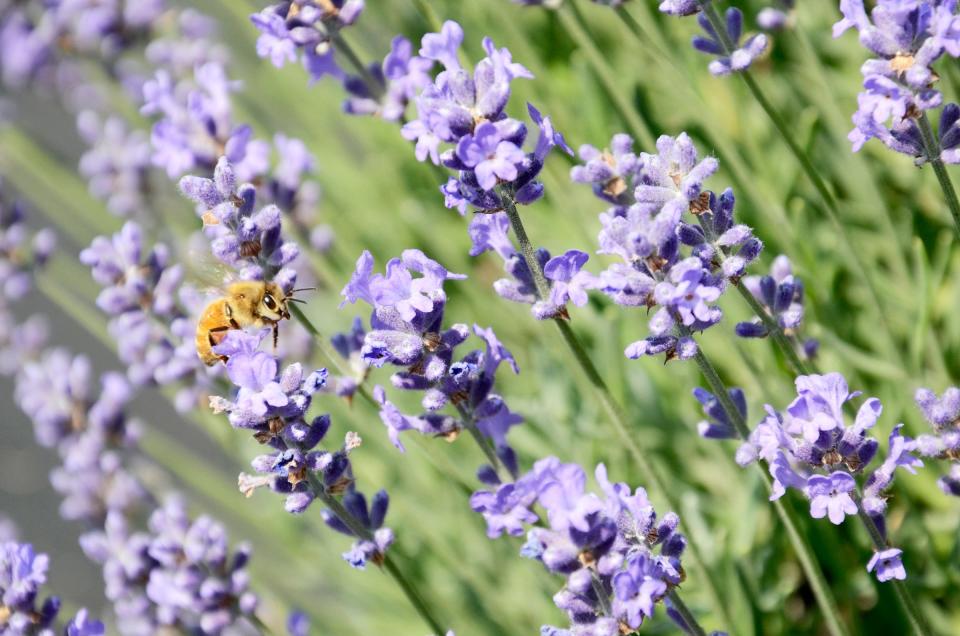Lavenders for drought tolerant gardens: Master Gardeners
Lavender is a delightful and useful garden plant. It can be used as a drought-tolerant low hedge, a specimen plant, a cut flower, and an herb that provides a fragrant addition to any garden. As garden ornamentals, lavenders have attractive gray-green foliage and eye-catching, long lasting blooms.
Lavender has many uses. “Lavender” comes from the Latin “lavare”, meaning “to bathe.” Hence it has a strong association with cleansing, aromatic pleasure, and burning of incense to clean the air. Lavender was used by the Egyptians in mummification, the Romans in their bathhouses, and medieval monks in tonics and laundries.
In terms of its herbal uses, the flower consists of a volatile oil that contains several organic constituents. Medicinally, these chemicals act to aid digestion, increase superficial blood circulation, and have been used as antispasmodics and anti-depressants. Lavender, with its cool, relaxing scent, is also used as a natural sleep aid.
In culinary use, flowers from English lavenders are used in herbal teas, cookies, and ice cream, but lavender’s best uses are in cosmetics and fragrances. Lavender is used in aromatherapy, as a relaxant, and as an antiseptic. Its oils are prized for soap fragrances, for aromatic baths, potpourri and sachets, facial oil, massage oil, floral water, compresses, perfume, facial steam, and inhalation.

Talking taxonomy, lavender is in the mint family and belongs to the genus Lavandula. The nomenclature of lavenders describes the leaf shape. English lavender, "L. angustifolia", is a narrow leafed variety while "L. latifolia" is broad-leafed, and "L. x intermedia" is a hybrid between L. angustifolia and L. latifolia, having intermediate leaf characteristics.
The numerous cultivars of English lavenders include dwarf forms (Compacta and Compacta Nana), pink-flowered (Jean Davis or Lodden Pink), blue-flowered (Graves, Grey Lady and Irene Doyle), and the large purple-flowered selections (Twickel, Purple Hidcote, Munstead, and Vera). Lavender Lady is excellent for garden use. Hidcote and Royal Velvet hybrids yield shorter-stemmed flowers but retain an excellent blue color when dried. There are also some variegated lavenders to add visual interest. Temperatures during the drying period have a significant effect on the final flower color since higher ambient temperatures can cause a bleaching effect.

Lavenders are native to the Mediterranean areas of Europe, which experience warm, dry summers and cool, rainy winters. They grow best in full sun in well-drained gravelly soils with low fertility. Excessive nitrogen encourages soft, succulent growth leading to plants breaking apart in the center. They will not tolerate wet, poorly-drained soils. In soils that have slower drainage, consider planting on mounds to drain excess water away from the root crown.
Irrigation is needed, however, in dry areas while the plants are being established. Drip irrigation systems are recommended, since overhead watering tends to break the plants apart and promotes disease. A soil pH of 6.5 to 7.5 is best.
Prune lavenders as you harvest the flower stalk. In a garden situation, even if you are not planning to harvest the crop, the best time to prune is just after the plants have completed their flowering cycle.
The most frequent challenges associated with lavenders are related to root and crown rots, usually the result of too much water or poor drainage in heavy soils. Excessive irrigation during summer months, overhead watering, and too much moisture near the main stem can also lead to root, stem and crown rot. When using drip irrigation, place the emitters several inches away from the stem.
Lavenders are not often bothered by insect pests, although they may occasionally attract spittlebugs. These insects are not usually a problem unless the plants are being grown for cut flowers and the spittle is in the flower heads.
October is the best planting month of the year in the southern San Joaquin Valley and a great time to plant Mediterranean adapted plants. Planting several varieties of lavenders will give your garden a long blooming season with no pests, little water, and ancient beauty.
So put lavenders on your shopping list and keep them in mind for fall planting. For more information on drought tolerant gardening and irrigation tips, visit the MG website listed below.
Are you interested in becoming a Master Gardener? Our next class runs January 26 through May 24, 2024. We will be holding a mandatory orientation on Fri., Oct 13 @ 1 pm. Register online: https://ucanr.edu/sites/UC_Master_Gardeners/ -- select “Become a Master Gardener”.
Please call our office with any questions (559) 684-3300
The Tulare-Kings Counties Master Gardeners will answer your questions in person:
Sept. 16 - Hofman's Nursery Plant Clinic, 12491 W Lacey, Hanford, 10 am – 1 pm
Sept. 21 - Kings Co. Resource Fair, Hanford Civic Auditorium, 5-7 pm
Questions? Call the Master Gardeners:
Tulare County: (559) 684-3325, Tues & Thurs, 9:30-11:30;
Kings County: (559) 852-2736, Thursday Only, 9:30-11:30 a.m
Visit our website for past articles, sign up for our e-newsletter, or email us with your questions: http://ucanr.edu/sites/UC_Master_Gardeners/
Facebook: https://www.facebook.com/mgtularekings14/ ; Instagram at: @mgtularekings
This article originally appeared on Visalia Times-Delta: Lavenders for drought tolerant gardens: Master Gardeners

